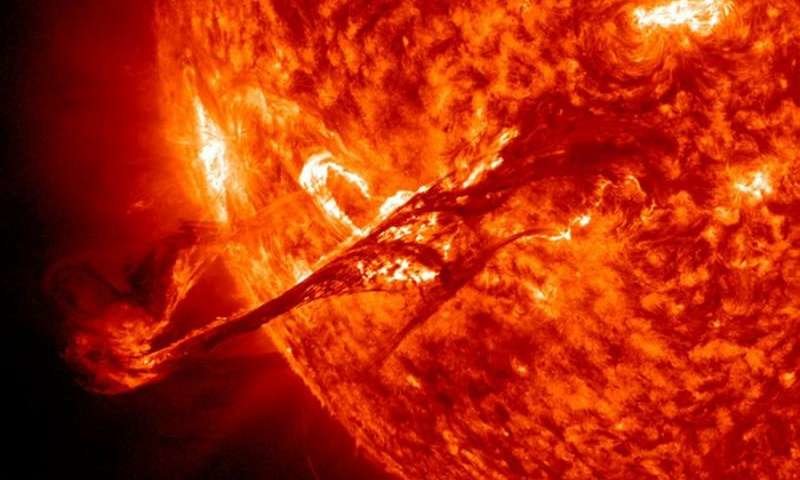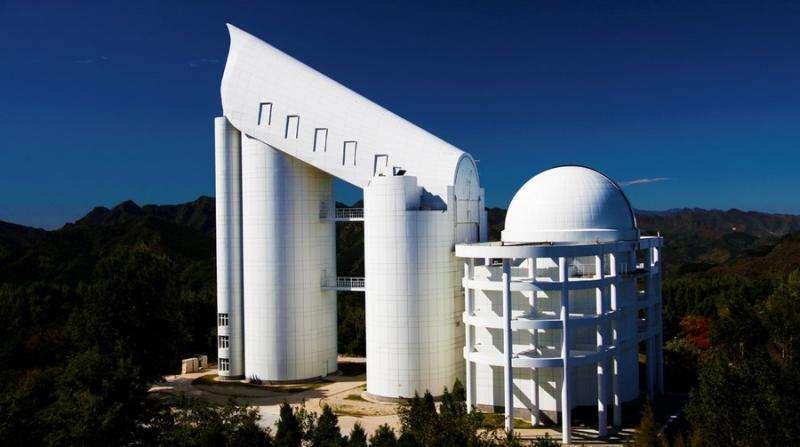
The Earth is often struck by solar eruptions. These eruptions consist of energetic particles that are hurled away from the sun into space, where those directed towards Earth encounter the magnetic field around our planet. When these eruptions interact with Earth's magnetic field, they cause beautiful auroras, poetic phenomena that remind us that our closest star is an unpredictable neighbor.
When the sun pours out gigantic amounts of hot plasma during large solar eruptions, it may have severe consequences on Earth. Solar eruptions are, however, nothing compared to the eruptions we see on other stars, so-called 'superflares'. Superflares have been a mystery since the Kepler mission discovered them in larger numbers four years ago.
Questions arose: Are superflares formed by the same mechanism as solar flares? If so, does that mean that the sun is also capable of producing a superflare?
An international research team led by Christoffer Karoff from Aarhus University, Denmark, has now provided alarming answers to some of these questions, which have been published in Nature Communications.
The dangerous neighbor
The sun is capable of producing monstrous eruptions that can break down radio communication and power supplies here on Earth. The largest observed eruption took place in September 1859, where gigantic amounts of hot plasma from our neighboring star struck the Earth.
On 1 September 1859, astronomers observed how one of the dark spots on the surface of the sun suddenly lit up and shone brilliantly over the solar surface. This phenomenon had never been observed, and nobody knew what was to come. On the morning of September 2, the first particles from this enormous eruption on the sun reached the Earth.
The 1859 solar storm is also known as the "Carrington Event." Auroras associated with this event could be seen as far south as Cuba and Hawaii; telegraph system worldwide went haywire, and ice core records from Greenland indicate that the Earth's protective ozone layer was damaged by the energetic particles from the solar storm.
Obeservations of such eruptions on other stars revealed that they can be up to 10,000 times larger than the Carrington event.
Solar flares occur when large magnetic fields on the surface of the sun collapse. When that happens, huge amounts of magnetic energy are released. Christoffer Karoff and his team have used observations of magnetic fields on the surface of almost 100,000 stars made with the new Guo Shou Jing telescope in China to show that these superflares are likely formed via the same mechanism as solar flares.
"The magnetic fields on the surfaces of stars with superflares are generally stronger than the magnetic fields on the surface of the sun. This is exactly what we would expect if superflares are formed in the same way as solar flares," explains Christoffer Karoff.
Can the sun create a superflare?
It does not seem likely that the sun should be able to create a superflare, as its magnetic field is too weak.
However, out of all the stars with superflares that Christoffer Karoff and his team analyzed, around 10 percent had a magnetic field with a strength similar to or weaker than the sun's magnetic field. Therefore, even though it is not very likely, it is not impossible that the sun could produce a superflare.
"We certainly did not expect to find superflare stars with magnetic fields as week as the magnetic fields on the sun. This opens the possibility that the sun could generate a superflare—a very frightening thought," says Christoffer Karoff.
If an eruption of this size was to strike the Earth today, it would have devastating consequences, not just for all electronic equipment on Earth, but also for our atmosphere and thus our planet's ability to support life.
Trees hid a secret
Evidence from geological archives has shown that the sun might have produced a small superflare in AD 775. Here, tree rings show that anomalously large amounts of the radioactive isotope 14C were formed in the Earth's atmosphere. 14C is formed when cosmic ray particles enter the Earth's atmosphere. These can originate from the Milky Way or via especially energetic protons from the sun formed in connection with large solar eruptions.
The studies from the Guo Shou Jing telescope support the notion that the event in AD 775 was indeed a small superflare, i.e. a solar eruption 10 to 100 times larger that the largest solar eruption observed during the space age.
"One of the strengths of our study is that we can show how astronomical observations of superflares agree with Earth-based studies of radioactive isotopes in tree rings," says Christoffer Karoff.
In this way, the observations from the Guo Shou Jing telescope can be used to evaluate how often a star with a magnetic field similar to the sun would experience a superflare. The new study shows that the sun, statistically speaking, should experience a small superflare every millennium. This is in agreement with idea that the event in AD 775 and a similar event in AD 993 were, indeed, caused by small superflares on the sun.

The problem is that conventional telescopes are only capable of obtaining one spectrum of a single star at a time. Therefore, if the observations were to be made with another telescope, such as the Nordic Optical Telescope on La Palma—a telescope the research group has used before —it would require 15 to 20 years of continuous observations.
The Guo Shou Jing telescope, or LAMOST as it is also called, is optimized for obtaining spectra of up to 4,000 stars simultaneously, as 4,000 optical fibers are connected to the telescope. This makes it possible to observe 100,000 stars in only a few weeks and it is this special capability that has made it possible to generate the new results.
More information: Christoffer Karoff et al. Observational evidence for enhanced magnetic activity of superflare stars, Nature Communications (2016).



[Link]
[Link]
Above describes the magnetism in intense light traveling thru a non conductive field. From 2011 research and where is it now?
[Link]
Explores how solar magnetic fields can be hidden.
Perhaps others besides myself suspect the sun, Sol, is a magnetar. There used to be papers on the net by authors that thought so. Is it me or does it seems that internet stuff is not authored papers anymore from the deep dark and enriched in thinking past and the pool is much minimized?